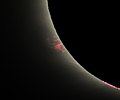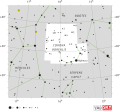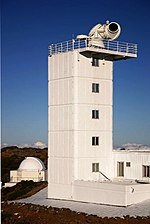populated by intermittent coronal structures known as solar prominences or filaments. The Sun's corona lies above the chromosphere and extends millions of...
62 KB (7,677 words) - 00:54, 25 September 2024
The solar wind is a stream of charged particles released from the Sun's outermost atmospheric layer, the corona. This plasma mostly consists of electrons...
55 KB (6,597 words) - 06:00, 11 October 2024
the much brighter photosphere, and extend outwards into the solar corona. While the corona consists of extremely hot plasma, prominences contain much cooler...
17 KB (1,885 words) - 08:42, 22 June 2024
structure in the Sun's corona Solar wind, the stream of particles and plasma emanating from the Sun Active region, where most solar flares and coronal mass...
2 KB (276 words) - 17:25, 30 June 2024
Corona from Fogged Eyeglasses Experimental simulations of pollen coronas The Corona Forest Corona Solar Corona at Golden Gate Bridge Partial Corona at...
4 KB (397 words) - 03:56, 20 August 2024
Sun (redirect from Solar diameter)
significant new data on solar wind and the solar corona. The Helios 1 and 2 probes were U.S.–German collaborations that studied the solar wind from an orbit...
167 KB (18,910 words) - 23:13, 12 October 2024
the mission of making observations of the outer corona of the Sun. It will approach to within 9.86 solar radii (6.9 million km or 4.3 million miles) from...
90 KB (8,189 words) - 12:37, 24 August 2024
the corona. The instruments CDS, EIT, LASCO, SUMER, SWAN, and UVCS are used for this solar atmosphere remote sensing. Making observations of solar wind...
29 KB (2,841 words) - 22:00, 9 September 2024
completely obscures the bright light of the Sun, allowing the much fainter solar corona to be visible. During an eclipse, totality occurs only along a narrow...
83 KB (9,739 words) - 15:30, 3 October 2024
Lockheed Martin Solar and Astrophysics Laboratory (LMSAL), provides continuous full-disk observations of the solar chromosphere and corona in seven extreme...
26 KB (2,398 words) - 01:05, 12 August 2024
Sun's atmosphere. They affect all layers of the solar atmosphere (photosphere, chromosphere, and corona). The plasma medium is heated to >107 kelvin, while...
49 KB (5,229 words) - 18:40, 15 August 2024
subjected to an external magnetic field, such as the solar corona and Earth's ionosphere. The corona is generally treated with the "cold plasma approach...
76 KB (9,175 words) - 01:39, 18 September 2024
The Toyota Corona (Japanese: トヨタ・コロナ, Toyota Korona) is an automobile manufactured by the Japanese automaker Toyota across eleven generations between 1957...
105 KB (10,223 words) - 05:31, 4 October 2024
Milky Way, Corona Australis contains one of the closest star-forming regions to the Solar System—a dusty dark nebula known as the Corona Australis Molecular...
52 KB (4,974 words) - 08:37, 18 August 2024
Coronal mass ejection (category Solar phenomena)
plasma mass from the Sun's corona into the heliosphere. CMEs are often associated with solar flares and other forms of solar activity, but a broadly accepted...
58 KB (6,828 words) - 11:32, 12 September 2024
one billion light-years from the Solar System containing more than 400 members, and is itself part of the larger Corona Borealis Supercluster. Covering...
55 KB (6,379 words) - 08:00, 1 October 2024
astrophysics surged and many solar telescopes were constructed. The 1931 invention of the coronagraph allowed the corona to be studied in full daylight...
48 KB (5,256 words) - 06:59, 3 September 2024
Heliosphere (section Solar wind)
described as a deflated croissant. The solar wind consists of particles (ionized atoms from the solar corona) and fields like the magnetic field that...
63 KB (6,605 words) - 05:02, 4 October 2024
A solar telescope or a solar observatory is a special-purpose telescope used to observe the Sun. Solar telescopes usually detect light with wavelengths...
17 KB (1,884 words) - 13:37, 24 September 2024
Structure of the Sun Solar core Radiative zone Convection zone Photosphere Chromosphere Corona Solar granulation Sunspots Solar prominences Solar flares Physical...
12 KB (1,050 words) - 22:56, 21 August 2024
Articles related to the Sun include: Corona Solar wind Coronal mass ejection(CME) Solar eclipse total eclipse annular eclipse hybrid eclipse partial eclipse...
3 KB (344 words) - 09:41, 9 February 2023
observations with NASA's Parker Solar Probe mission (2018–2025) which is performing measurements of the Sun's extended corona, as well as other ground-based...
39 KB (3,145 words) - 01:00, 4 September 2024
Coronium (section Solar spectroscopy)
The name, inspired by the solar corona, was given by Gruenwald in 1887. A new atomic thin green line in the solar corona was then considered to be emitted...
5 KB (517 words) - 09:33, 21 July 2024
Coronal hole (category Solar phenomena)
reveal the structure of the corona. Coronal hole size and population correspond with the solar cycle. As the Sun heads toward solar maximum, the coronal holes...
8 KB (878 words) - 05:49, 22 June 2024
The solar storms of May 2024 were a series of powerful solar storms with extreme solar flares and geomagnetic storm components that occurred from 10–13...
49 KB (3,604 words) - 18:56, 9 October 2024
Large Angle and Spectrometric Coronagraph (category Solar and Heliospheric Observatory)
from 3.7 to 30 solar radii (blue) The first principal investigator was Dr. Guenter Brueckner. These coronagraphs monitor the solar corona by using an optical...
4 KB (408 words) - 18:47, 9 October 2024
fields in the solar surface. The solar magnetic field structures the corona, giving it its characteristic shape visible at times of solar eclipses. Complex...
89 KB (10,014 words) - 10:42, 21 September 2024
multiple layers below the corona that lead to solar eruptions. To study space weather, and the origin, composition and dynamics of solar wind. The mission was...
41 KB (3,575 words) - 21:58, 9 September 2024
WISPR (category Parker Solar Probe)
images of the corona, solar wind, shocks, solar ejecta, etc. Development of WISPR was led by the U.S. Naval Research Laboratory. The Parker Solar Probe with...
10 KB (1,040 words) - 21:05, 7 March 2024
Coronal loop (redirect from Solar coronal loop)
wind. A diagram showing the evolution of the solar magnetic flux over one solar cycle Diagram of the low corona and transition region, where many scales of...
13 KB (1,691 words) - 16:17, 9 September 2024

























